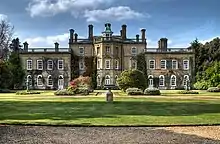Pylewell Park
Pylewell Park is a country house and park near Lymington in Hampshire, England and is the ancestral home to the Roper-Curzon family since 1879.[2] It is listed at grade II*.[3] It occupies 1500 acres and includes 33 houses, 20 apartments, church, private beach, a fifteen-acre private lake and house gardens of 27 acres.[4][5][6][7]
Pylewell Park | |
|---|---|
 | |
| Net worth | $100 million dollars[1] |
History
The Domesday Book records the Pylewell estate. It dates back to the 12th century where Knights Templar Preceptor occupied it which was located on the Baddesley Manor site.[8] Sir Richard Worsley lived in Pylewell Ground in 1609. Afterward, the family of Worsley built the house on the present site near Appuldurcombe. During the 17th century, Pylewell estate was fortified to Jacobean Lodge.[9] Ascanius William Senior started leasing this park and by 1787 he eventually bought it.[10][11][12]
From 1787 to 1801 Thomas Robbins bought the park and removed most of the formal gardens elements and introduced ornamental walks and informal schemes of parkland. Thomas Weld acquired the estate in 1801 for his third son, Joseph, as a wedding gift. Joseph, aged 25 years, actively dealt with all affairs of the estate up to 1828.[9] He made extensive enhancements to the gardens and farms such as North Park improvements in 1818. Additionally, in 1822 the South Lake was constructed. More improvements continued including the avenue of southern Solent in additional to lay grounds in the formal garden and this occurred in the early eighteen century. By 1854, William Peers of Williams’s Freeman started improving Weld’s construction as well as the Pylewell grounds. A circular parterre was included in the house of the southeast as more land was bought in the school village of Baddesley.[13][14]
Before 1874 when William Ingham Whitaker, member of the Whitaker family, acquired the Pylewell estate, it was owned by nearly four more owners including Mr. Thomas Robins, Thomas Weld, Joseph Weld, and Joseph Worker.[15] As soon as he acquired the estate, he added a new lodge and drive among other important changes to the house. After his death in 1893 his son William Ingham Whitaker, succeeded him and made more significant alterations. In 1903 he married and traveled to Japan.[9] Accordingly, he developed the pleasure grounds with Australasian and Asian plant collections including bridges and a new lily pond. Between 1912 and 1920s he gradually established rhododendrons collection on the lake banks. This is the time in which all the gardens attained their most decorative stage. Although in 1936 the William Ingham Whitaker III inherited the estate, it was demolished in 1951.[9] This happened during wartime where east and west wings of the house and parkland were affected. Lady Elspeth Grace Whitaker, the 6th Marchioness of Northampton, heir to the fortune and member of the Whitaker family, inherited Pylewell Park and left it to her son, Lord John Christopher Ingham Roper-Curzon, 20th Baron of Teynham in 1988.[8][16][17]
Modern house
Since 1879, it has belonged to members of the House of Roper and House of Curzon. Today, David John Henry Roper-Curzon, the eldest son of Lord Teynham, lives in it with his eldest son, Henry “Harry” Christopher Roper-Curzon, and his other children. The house has a sea aspect as well as countryside sweeping views because it is set in 1,500 acres, with a private beach, a 15-acre lake and house gardens of 27 acres.[9][18][19]
References
- "House of Roper-Curzon". Obson. March 23, 2020.
- "Interiors: Pylewell Park in Hampshire". The Telegraph. July 12, 2014.
- Historic England. "Pylewell Park (1000169)". National Heritage List for England. Retrieved 24 January 2020.
- "Pylewell Park". The New Forest. Retrieved January 3, 2020.
- "Pylewell Park, Hampshire, South East". Coco Wedding Venues. Retrieved January 3, 2020.
- "Property details for Flat 1 Pylewell Park Pylewell East End Lymington SO41 5SJ - Zoopla". www.zoopla.co.uk.
- Dickie, John (February 4, 2011). "Cosa Nostra: Historia de la mafia siciliana". Penguin Random House Grupo Editorial España – via Google Books.
- "A History of Pylewell Park". Pylewell Park. March 1, 2016.
- Burke, B. (2016). A genealogical and heraldic history of the landed gentry of Great Britain & Ireland. London: Henry Colburn.
- "Campsite in the New Forest at Pylewell Park | Embers Camping". www.emberscamping.co.uk.
- "Pylewell Park Weddings - Brochure Design, Print Management by Tinstar".
- Venn, John (September 15, 2011). "Alumni Cantabrigienses: A Biographical List of All Known Students, Graduates and Holders of Office at the University of Cambridge, from the Earliest Times to 1900". Cambridge University Press – via Google Books.
- "Pylewell Park Mill, Boldre - Images & Documents". catalogue.millsarchive.org.
- "Curious Arts Festival to come to Hampshire's Pylewell Park this summer". Basingstoke Gazette.
- "Reflections: Pylewell Park – uncovering the story of a local landmark". Advertiser and Times. May 17, 2019.
- Walford, Edward (January 1, 1860). "The county families of the United Kingdom; or, Royal manual of the titled and untitled aristocracy of England, Wales, Scotland, and Ireland". Dalcassian Publishing Company – via Google Books.
- "Pylewell Park, Lymington - Hampshire Wedding & Event Venue". burlisonphotography.com.
- "Pylewell Park, England - Images | The Interior Archive". interiorarchive.photoshelter.com.
- "Pylewell Park Wedding Venue Lymington, Hampshire". hitched.co.uk.